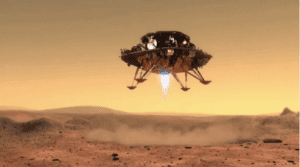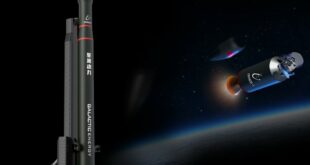by Blaine Curcio and Jean Deville
 As part of the partnership between SpaceWatch.Global and Orbital Gateway Consulting we have been granted permission to publish selected articles and texts. We are pleased to present “Dongfang Hour China Aerospace News Roundup 10 May – 16 May 2021”.
As part of the partnership between SpaceWatch.Global and Orbital Gateway Consulting we have been granted permission to publish selected articles and texts. We are pleased to present “Dongfang Hour China Aerospace News Roundup 10 May – 16 May 2021”.
Hello and welcome to another episode of the Dongfang Hour China Aero/Space News Roundup! A special shout-out to our friends at GoTaikonauts!, and at SpaceWatch.Global, both excellent sources of space industry news. In particular, we suggest checking out GoTaikonauts! long-form China reporting, as well as the Space Cafe series from SpaceWatch.Global. Without further ado, the news update from the week of 10 May – 16 May 2021.
1) Chinese Tianwen-1 Mars Missions attempts Atmospheric Entry and Landing of the Zhurong Rover
Jean’s Take

After an unbearable suspense last Saturday (15/05), China successfully landed the Zhurong rover and its lander module on Mars. One of the reasons the suspense was unbearable was due to the absolute non-coverage on the Chinese side, leaving space fans with what amateur or non-official radio astronomers were able to get from the signals the Tianwen-1 orbiter was sending back. A big thanks to observatories like the Bochum Observatory which were able give us hints of what was going on, even there were signal blackouts now and then due to the very high gain antennas required for deep space communications (see the size of the deep space network used by China for Tianwen-1).
Let’s briefly go through what the Tianwen-1 mission went through yesterday, which is undeniably an extraordinary feat of combining cutting-edge materials sciences, radio communications, flight dynamics, and advanced automation. The whole landing process was entirely automated due to the fact that signals usually take a dozen or so minutes to reach Earth.
- Atmospheric Entry
The Tianwen-1 spacecraft was initially in an elliptical parking orbit of 265 x 15000 km . The landing sequence was kicked off when the orbiter slowed itself and left its initial parking orbit to a lower orbit to release the Zhurong entry capsule. The entry capsule itself looks like a cone-shaped structure which is composed of the heat shield and the parachute module, and it also contains the lander and rover.
Before the separation, the latest navigation parameters are communicated to Zhurong, which will after separation rely only on inertial navigation. After the separation, the orbiter boosts itself back into a higher orbit and the Zhurong entry capsule enters a ballistic trajectory. And as Zhurong approaches the red planet, starts to feel the effect of the Martian atmospheric drag around 125 km of altitude. This kicks off the Atmospheric entry phase, which is the first braking phase and where the capsule relies essentially on atmospheric drag to slow down. This is an extremely efficient way of slowing down: the capsule goes from an initially massively hypersonic speed of 4.8 km/s (probably something like Mach 10-15) to supersonic speeds of around Mach 2-ish. This is done at the cost of massive heating, which is absorbed thanks to a powerful heat shield which is shaped like a spherical cone of 70°. According to various Chinese sources, the trajectory during this part is semi-ballistic, semi-meaning that the capsule has an non-zero angle of attack (basically the angle between the axis of symmetry and the velocity vector), and generating lift for the capsule. This increases the heating constraints but enables the Zhurong lander/rover to maneuver a bit more and experience less severe accelerations. - Parachute Deployment
Once the capsule slowed down to around Mach 2 (several hundreds of m/s), the supersonic parachute deploys, slowing down the spacecraft further. As the speed further slows down to subsonic speeds, the heat shield is no longer useful and is discarded to enable a telemetric laser and a microwave velocity sensor to correct the inertial navigation data. - Powered Descent
As the lander slows down to about 100 m/s, the parachute becomes ineffective due to the very thin atmosphere of Mars. The entry capsule and the parachute are then entirely discarded, kicking off the powered descent phase, where the lander fires off and relies on its main 7500N variable thrust engine to continue to slow down the the lander, and notably it is able to maintain a hover in the final stages to enable the on-board optical sensors to image the terrain to select a suitable landing area, avoiding any potential difficult spots. Also worth mentioning, during the entire powered descent phase, there are also small reaction control thrusters to control the attitude of the lander (there’s a total of 48 engines on-board the Tianwen-1 mission!). The last bit of velocity is then absorbed by the lander’s 4 landing legs.
Worth noting, the rover is not released immediately, the lander first deploys its solar panels, establishes communications with the orbiter (which serves as a relay), and performs imaging of its surroundings. The rover is released only several Martian days (sols) later.
So China becomes the second nation in history to independently land on Mars, after the US (if we ignore semi-failed attempts from Europe and Russia/USSR). Of course, a lot of things can still go wrong before the Zhurong rover starts roaming the Red Planet, but it’s safe to say that considering that this was the first independent Mars mission from China, it’s a real success already.
It’s also interesting to note the extent to which China is able to reuse technology from past missions, but also improve incrementally from a technological standpoint in between missions. This is something we saw for example with the Shenzhou capsule, the Tianzhou cargo resupply, and the Tiangong experimental space stations.
It’s also the case for the Tianwen-1 mission’s lander, which consists of a circular platform resembling Chinese Chang’e 3/4 lander, and with a main variable thrust engine in the center.
This engine is also an example of incremental improvements. It is the same 7500N engine used during the Chang’e 3-4 landings, but according to the manufacturer AALPT, the structure was optimized, a novel 3D printing technology was used, the pressure in the combustion chamber was increased, and the size of the engine reduced, dividing the weight and volume by 3.
Blaine’s Take
Thanks Jean for an excellent summary of the Zhurong mission, and big congratulations to the CNSA and the various teams from CASC that made this mission happen, super inspiring and interesting to watch. A few points to add:
Not that our viewers need telling, but this was a hugely significant mission. We saw a congratulatory message from Chinese President Xi Jinping following the successful landing, saying “You were brave enough for the challenge, pursued excellence and placed our country in the advanced ranks of planetary exploration,” he said. “Your outstanding achievement will forever be etched in the memories of the motherland and the people.” Powerful and patriotic stuff.
This mission also provides an illustrative example of the complexity of China’s space program, and the very large number of major projects being done in parallel. For example, it feels like ages ago because Covid has caused life to become a time-warp, but the Tianwen-1 mission lifted off from Wenchang all the way back in July 2020.
Since then, we have seen: 17x Yaogan EO/SIGINT satellites launched, multiple Gaofen, Huanjing, and Ziyuan satellites, the launch of the second and third Tiantong 1st generation satellites (China’s version of Inmarsat), and of course, the recent launch of the Tianhe core module of the Chinese space station. Separate to that, we’ve seen a lot happen on the ground, in that satellite factories have been opened, launch industrial bases have been completed, and a whole bunch of other stuff has gotten done. It’s kind of astonishing to think that during all of those things, there was also this Tianwen-1 mission heading towards Mars, and over the past few months, orbiting Mars as the orbiter collected data on landing sites and as (presumably) humans back in China were analyzing such data to help aid in decision-making.
In short, a busy, busy time in Chinese space, and I do not envy the person responsible for coordinating and managing all these disparate projects.
It’s also worth noting some major differences between China’s Zhurong and NASA’s Perseverance rover, which landed on the red planet just 3 months ago. For example, for the Tianwen-1 mission, the lander carries the rover during the entire landing process and the rover drives off once the landing is complete. This is unlike the US Mars 2020 mission where the Perseverance rover separates from the cruise stage during what is called the Skycrane maneuver, which is itself extremely impressive (we will post a graphic from NASA showing the maneuver).
The Zhurong rover weighs around 200 kg. This is much lighter/smaller than NASA’s Perseverance rover (around 1 ton), and therefore it also has fewer scientific instruments. The explanation to this size difference is that the payload of the Mars 2020 mission went essentially into the rover (there is no orbiter), whereas the Tianwen-1 mission consists of a rover (Zhurong) and the orbiter (Tianwen-1), which both had a set of scientific instruments. Perseverance also has, of course, the oft-cited helicopter–that’s right, we are at a point in human history where we have helicopters (or at least, a helicopter) flying around on Mars.
Some additional helpful sources [1][2]
2) Chinese Launch Company Galactic Energy signs Collaboration Agreement with China Huateng Group to Develop International Launch Opportunities
Blaine’s Take
On May 12th, Galactic Energy, one of the leading commercial launch companies, signed a strategic cooperation agreement with China Huateng (中国华腾工业有限公司) to develop the international launch market for Galactic Energy’s launch vehicles. The agreement was targeted on opportunities with the Ceres-1 (谷神星一号) solid-fueled small-lift launch vehicle, which was launched for the first time in November 2020.
This is an interesting update for several reasons. Firstly, it’s in the continuity of the positive dynamic of Galactic Energy: the company was founded in February 2018, and impressively managed to put into orbit their 1st rocket 2 years and 9 months later. That’s an impressive speed considering that they are one of the two only commercial companies to have managed this so far, the other company being iSpace. Noteworthy in the article is that 2022 is the target date for the first launch of the Ceres-1 rocket for an international customer.
The other point of interest here is that this is probably one of the first Chinese private launch companies seriously putting efforts in international business development. Interestingly, China Huateng is a subsidiary of CASIC (China Aerospace Science and Industry Corporation), a large aerospace conglomerate which… spun-off a competing launch company, Expace.

China Huateng has multiple subsidiaries dedicated to different industries, including one called Huateng Aerospace, which will likely be in charge of selling the launch services to domestic and international customers.
I suspect Huateng will be an increasingly important company to watch given their role within CASIC–according to their website, they are the main conduit through which CASIC conducts international business–basically they are sort of like to CASIC what China Great Wall Industry Corporation (CGWIC) is to CASC. Moving forward, as CASIC is doing more stuff in space, and as China is trying to find international customers for their space industry activities, companies like Huateng have an important role. It would be an interesting exercise to try to dig into what type of people are employed by Huateng. As a comparison, if we look at CGWIC, the executives that I know at the company tend to be people with backgrounds in things like English language studies, general business, or other areas that are a bit less hardcore technical, and a bit more conducive to working with people from different countries. This is important because for companies like CASIC and CASC, their core subsidiaries are pretty freaking traditional, and the people that work there in general are not so international in their outlook.
Jean’s Take
I’m curious to see what Galactic Energy will be able to achieve in international launch markets. While it is known that other launch companies have also searched for opportunities abroad, these efforts have been quite limited, and the focus has mainly been on the domestic market, but we’ve seen nothing as structured as this partnership with China Huateng. I expect that being backed by a large SoE like Huateng (also called Volinco) may have a significant impact on business development, similar to China Great Wall. We’ll have to see, and it’ll be interesting to observe if any of the other leading Chinese commercial launch companies such as Landspace of iSpace will follow suit. Speaking of iSpace…
3) iSpace Completes a Test of its Single-Layer Common Bulkhead Fuel Tank
Jean’s Take
Launch startup iSpace announced on 10 May that they had successfully completed a comprehensive test of their methalox common bulkhead tanks, to be used on the Hyperbola-2 rocket.
Common bulkhead tanks are a way to make tanks more compact, thus reducing weight and reducing the height of the rocket (which is beneficial for stability). On the other hand it means a bit more structural complexity and also thermal insulation between the two subtanks sharing the same wall.
In the case of iSpace’s Hyperbola 2, the common bulkhead technology should be a bit easier to manage due to the nature of the fuel and oxidizer used: the boiling point of liquid methane is -161°C, and it’s -183°C for oxygen. This difference of 20°C makes thermal insulation less critical than, say, for liquid hydrogen (with an extremely low boiling point of -253°C). And indeed this is something put forward by iSpace, which claims that there is no thermal insulation between the two subtanks.
The tests performed by iSpace concerned the plumbing systems that go with the tank (pressurizing system, valves, various electronics and sensors monitoring the fuel level and temperature). It included filling and discharging the tanks multiple times (simulating reuse), verification of the rigidity of the structure in the changing (low) temperature environment, and monitoring of the thermal environment with repeated reuse. The completion of this test brings iSpace one step closer to the hop tests of their Hyperbola 2 prototype, which should take place this year.
It’s great to be able to follow the progress of iSpace on a regular basis, with nice snapshots and videos (as reported in previous DFH episodes). The PR team has been quite good at being rather transparent with their progress, and I’m sure a lot of space fans are grateful for that.
Blaine’s Take
Nothing to add from my side on iSpace, but a final piece of news from the Phnom Penh Post (because when you get a piece of news from the Phnom Penh Post reporting on CGWIC, you report it!)
4) CGWIC to open an office in Phnom Penh, Cambodia, to promote BeiDou Adoption
Blaine’s Take
As published by the Phnom Penh Post on 12 May, CGWIC plans to open an office in Cambodia before the end of 2021 to help promote the adoption of BeiDou satnav technology in the transport sector in ASEAN. The announcement comes around 6 months after an MoU was signed between CGWIC and an unnamed Cambodian entity related to BeiDou, EO, and road mapping. Interesting update for sure, and not the first time that CGWIC has made inroads into Southeast Asia. In addition to the office in Phnom Penh, Cambodia had also allegedly bought a satellite from China back in 2018 in a ceremony overseen by none other than Li Keqiang. CGWIC also sold the LaoSat-1 satellite to Laos, which was launched in 2015.
Moving forward, it’s likely that we will see increased activity by CGWIC (and probably Huateng too!) in Southeast Asia, South Asia, and elsewhere in BRI regions. This may be particularly true for projects that require financing–for example, even if a developing country wanted to buy a rocket from Landspace, and even if Landspace was cheaper than a rocket from CALT, a big part of the equation would be whether the China export-import bank, or some similar institution, could finance the project. That being the case, a company like CGWIC or Huateng will almost certainly continue to have access to more preferential financing than commercial firms.
This has been another episode of the Dongfang Hour China Aero/Space News Roundup. If you’ve made it this far, we thank you for your kind attention, and look forward to seeing you next time! Until then, don’t forget to follow us on YouTube, Twitter, or LinkedIn, or your local podcast source.
Blaine Curcio has spent the past 10 years at the intersection of China and the space sector. Blaine has spent most of the past decade in China, including Hong Kong, Shenzhen, and Beijing, working as a consultant and analyst covering the space/satcom sector for companies including Euroconsult and Orbital Gateway Consulting. When not talking about China space, Blaine can be found reading about economics/finance, exploring cities, and taking photos.
Jean Deville is a graduate from ISAE, where he studied aerospace engineering and specialized in fluid dynamics. A long-time aerospace enthusiast and China watcher, Jean was previously based in Toulouse and Shenzhen, and is currently working in the aviation industry between Paris and Shanghai. He also writes on a regular basis in the China Aerospace Blog. Hobbies include hiking, astrophotography, plane spotting, as well as a soft spot for Hakka food and (some) Ningxia wines.
 SpaceWatch.Global An independent perspective on space
SpaceWatch.Global An independent perspective on space




